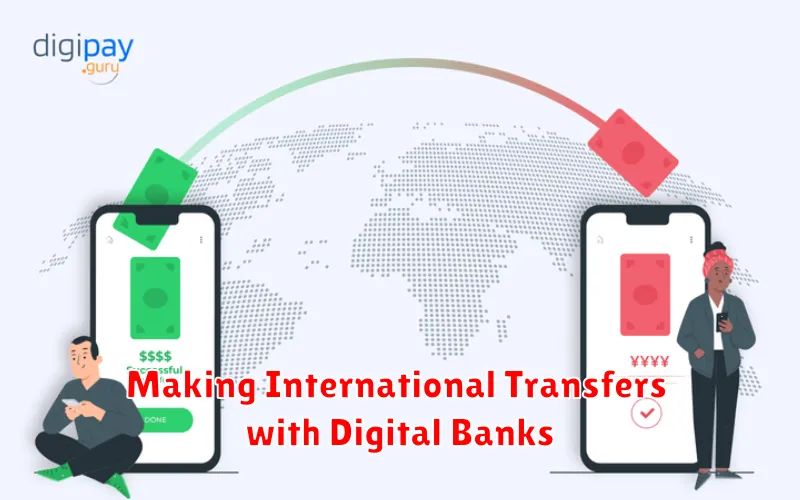Making international transfers has traditionally been a complex and costly process, often involving hefty fees, slow processing times, and confusing exchange rates. However, the rise of digital banks has revolutionized the way we send and receive money across borders. Digital banking platforms frequently offer significantly more competitive exchange rates and lower fees compared to traditional brick-and-mortar banks. This makes them an attractive option for individuals and businesses looking to make international money transfers efficiently and cost-effectively. This article will explore the advantages of using digital banks for international transfers, highlighting key features, benefits, and considerations.
Navigating the world of international transfers can be challenging. This article will delve into the process of making international transfers with digital banks, offering a clear and concise guide to help you make informed decisions. We will examine the various factors to consider when choosing a digital bank for international transfers, including security measures, supported currencies, transfer limits, and customer service. By understanding these key aspects, you can streamline your international transfer process and minimize potential complications. Learn how digital banking is changing the landscape of international finance and discover how to leverage these advancements to your advantage.
Are Digital Banks Global?
The global reach of digital banks is a complex issue. While they offer convenient and often cost-effective banking services, they aren’t universally accessible. Many digital banks operate primarily within a single country or a small number of regions due to regulatory hurdles, licensing requirements, and localized infrastructure.
Some digital banks are expanding internationally, partnering with established financial institutions to offer services in new markets. However, it’s important to remember that the specific features and functionalities of a digital bank can vary significantly from region to region.
Therefore, while the concept of digital banking is global, the availability and scope of individual digital banks remain largely regional.
Supported Countries and Currencies

Digital banks often provide services across a wide range of countries, but their specific reach varies. It’s crucial to verify whether your desired destination country is supported by the specific digital bank you are considering.
Similarly, the range of supported currencies is a key factor. While some digital banks offer transfers in numerous currencies, others may focus on a smaller selection. This can influence both the cost and convenience of your international transfers.
Check the digital bank’s official website or app for a comprehensive list of supported countries and currencies. This information is typically presented clearly and is essential for planning your international transfers.
Transfer Fees and Exchange Rates
When making international transfers with digital banks, fees and exchange rates are crucial factors to consider. Digital banks often advertise lower fees compared to traditional banks, making them an attractive option for international transfers.
Transfer fees can vary significantly. Some digital banks offer fee-free transfers, while others charge a fixed fee or a percentage of the transfer amount. Be sure to compare these fees across different digital banks to find the most cost-effective option for your needs. Pay close attention to any potential correspondent bank fees, which are fees charged by intermediary banks involved in the transfer process. These can sometimes be hidden and add to the overall cost.
Exchange rates are equally important. Digital banks typically use the mid-market rate or a rate very close to it. However, some may add a markup to the exchange rate, effectively increasing the cost of the transfer. Transparency in the exchange rate offered is essential. Compare the exchange rate offered by the digital bank with the current mid-market rate to understand if a markup is being applied.
Using SWIFT and IBAN Codes
When initiating international transfers with digital banks, you’ll frequently encounter SWIFT and IBAN codes. These codes are crucial for accurately routing your funds to the correct destination.
SWIFT, which stands for the Society for Worldwide Interbank Financial Telecommunication, acts as a unique identifier for banks globally. Think of it as an address for your bank in the international financial network. Each bank has its own distinct SWIFT code, allowing for secure communication and transfer of funds.
IBAN, or International Bank Account Number, identifies individual bank accounts. This code ensures your money reaches the specific recipient account. The IBAN varies in length and format depending on the country, but always includes country code, check digits, and bank and account details.
Digital banks typically provide the necessary SWIFT/BIC and IBAN information during the transfer setup process. Make sure to enter these codes accurately to avoid delays or misdirected funds. Double-checking these details is essential for a successful international transfer.
Security During Global Transfers

Security is a paramount concern when making international transfers. Digital banks employ various measures to protect your funds and personal information during these transactions.
Encryption plays a crucial role in securing your data. Strong encryption protocols safeguard your information from unauthorized access as it travels across networks.
Two-factor authentication (2FA) adds an extra layer of security. This requires you to verify your identity using two different methods, such as a password and a one-time code sent to your phone.
Fraud monitoring systems are constantly working to detect and prevent suspicious activities. These systems analyze transaction patterns and flag any potentially fraudulent behavior.
In addition to these security measures, you can also take steps to protect yourself. Be cautious of phishing attempts and never share your login credentials or sensitive information with anyone. Regularly monitor your account activity for any unauthorized transactions.
Tracking International Payments
Tracking your international payment is crucial for peace of mind and effective financial management. Digital banks offer various tools and methods to monitor your transfer’s progress.
Most digital banks provide real-time tracking through their mobile app or online banking platform. You can typically view the status of your payment, such as “pending,” “processing,” or “completed.” Some banks even offer notifications via email or SMS to keep you informed of any updates.
Reference numbers are essential for tracking purposes. Keep a record of the unique transaction reference provided by your digital bank. This will be invaluable if you need to inquire about your payment’s status or if any issues arise.
If your payment is taking longer than expected, contact your digital bank’s customer support. They can provide specific details about your transfer and help resolve any delays.

